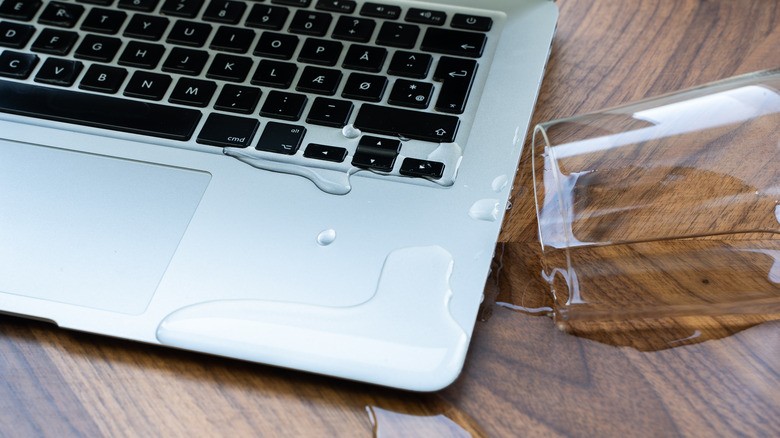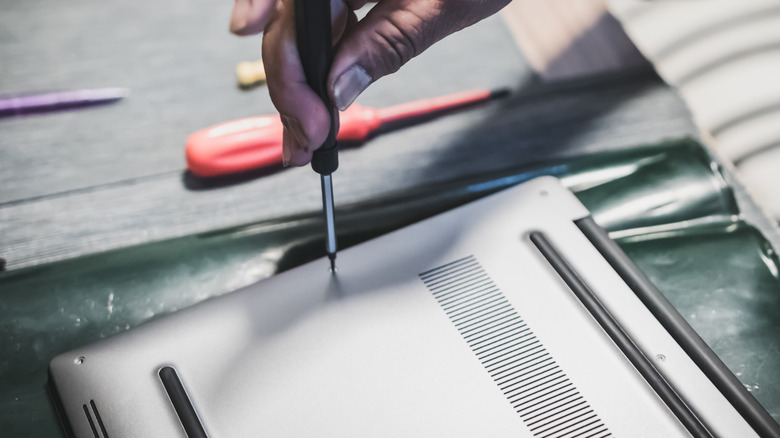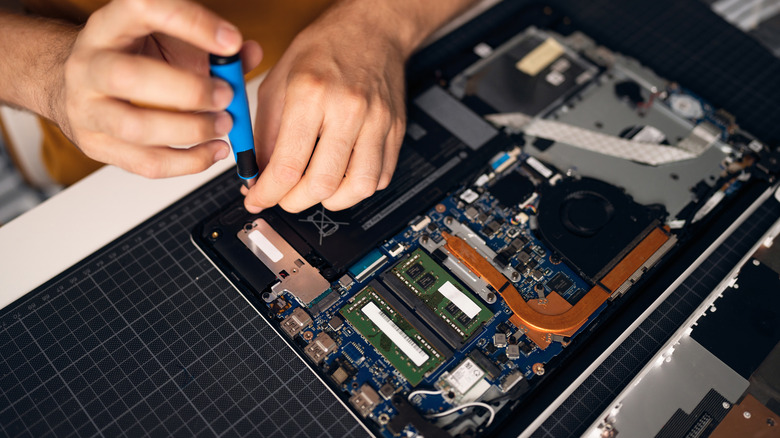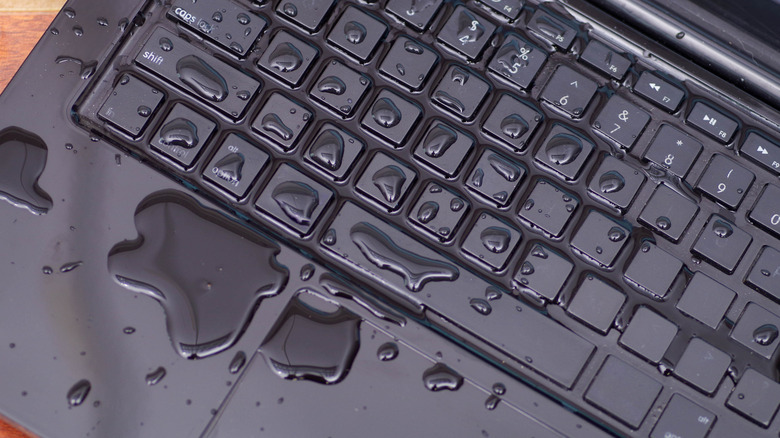The First Thing You Need To Do If You Spill Water On Your Laptop
So, you had a glass of water beside your laptop, and while trying to figure out something on the screen, you reached out for it and mistakenly spilled water all over the laptop. Well, you've got to act fast, as every second you spend thinking could add to the repair bill.
The first thing you should do is turn the laptop off without caring about any open programs or unsaved tasks, or in other words, force a shutdown. However, do this with dry hands to save yourself from electric shocks. Also, ensure that you aren't standing in water.
Press and hold the power button for five to 10 seconds until the screen goes black, and you can't hear the cooling fan anymore. This reduces the chances of a short circuit. Do not try to shut down your laptop properly, as, in some cases, this could take as much as a minute, and we do not have that time to spare. If the laptop was already off when you spilled water, do not turn it on unless you're sure it's dry.
Next, unplug the power cable from your laptop and all other peripherals, such as a mouse, keyboard, card reader, external storage driver, secondary monitor, etc.
Turn the laptop upside down and remove the back panel
Once you've quickly turned your laptop off and unplugged all the accessories, turn it upside down on a towel or an absorbent cloth. This drains out most of the water that entered the laptop through the tiny openings around the keys.
While this is easier with a laptop whose lid turns 180 degrees, you might have to use a pile of books or the table corner to place regular laptops at an angle so that the keyboard is on the towel and the screen hangs down. Be very careful while doing this; don't let the laptop slip.
As the laptop drains, disconnect its battery to prevent water damage. If your laptop has a removable battery, press the latch on the rear panel and immediately remove it. However, if your laptop's battery is hidden underneath the backplate, you must remove it to disconnect the battery cell. If you aren't comfortable disconnecting the battery, just unscrew the backplate and set it aside, which will help air-dry the laptop. Ideally, you should leave your device in this position for at least a day.
After a day, place everything back together and take the laptop to the nearest service center. Let the professionals perform any further diagnosis to ensure everything is working properly.
Detach the internal components
If you have some experience servicing a computer, perhaps you installed RAM in your PC, or you performed successful surgery on your laptop, we recommend removing the battery and other internal components, such as the RAM, solid-state drive, and processing unit, as even the tiniest drop of water can render them useless.
Examine these parts carefully, especially if what you've spilled wasn't 100% water. Soak the water using a microfiber cloth if you see any wet portions. Use a cotton swab to wipe the tricky corners. At this point, leave everything to dry for at least a day. If possible, place the setup in a non-humid warm area, or otherwise, leave it in your room with the fan on for a day.
Once everything is clean and dry, put the parts back on the motherboard, screw the backplate in place, and try turning it back on. If the methods mentioned here don't work, depending on the severity of water damage, and your laptop doesn't turn on, consider visiting a service center.
Stay clear of a blow dryer or a bucket of rice
While we've listed methods to save your laptop in case of a spillage, there are a few things that won't help as much as you think they would. First, you should never use a blow dryer on a device, whether a smartphone or a laptop, as its heat can do more harm than good. Further, you shouldn't keep your laptop out in the sun as it could heat the components, such as the battery, RAM, and CPU, beyond their operational temperature limit, causing harm.
Storing your device in a bucket of rice doesn't help, either. In fact, if the rice grains get stuck in small openings, such as the USB-A ports on a Windows laptop or the USB-C ports on a MacBook, you might have to get them replaced.
If you're trying to clean the internal components, do not spray or pour isopropyl alcohol directly on them. Instead, pour the liquid on the microfiber cloth or the cotton swab and gently rub it on the affected area. Last but not least, even if your laptop is spill-proof or water-resistant, do not turn it on in the middle of the drying process just to see whether it is working.



